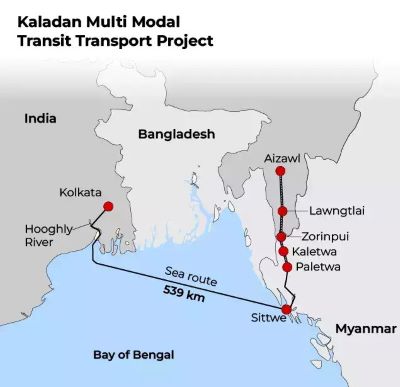Context-
In a significant development, India's initiative to take complete control of Myanmar's Sittwe Port through India Ports Global Ltd. (IPGL) highlights a pivotal shift in regional maritime strategy. This move underlines India's growing engagement in Myanmar and its broader strategic goals in the Indo-Pacific region.
Port Control and Regional Dynamics
India's decision to take over the management of Sittwe Port aligns with its broader strategic interests, particularly in countering Chinese influence in the region. With IPGL gaining complete operational control, India is poised to enhance its connectivity with Southeast Asia, especially Myanmar. This strategic move mirrors India's approach in the Chabahar Port in Iran, where India also seeks to secure maritime routes and bolster regional partnerships.
The extended lease agreement and IPGL's plans to develop the port signal India's commitment to transforming Sittwe into a key trade and logistics hub. By facilitating transactions in Indian rupees, India aims to strengthen economic ties with Myanmar and promote bilateral trade.
India's ambition to treat Sittwe Port like a domestic facility underscores its strategic vision to enhance regional security and stability. The integration of Sittwe Port into India's maritime infrastructure not only boosts economic prospects but also consolidates India's maritime influence in the Bay of Bengal.
Trade and Economic Impact
The Kaladan Multimodal Transit Transport Project (KMTTP), centered around Sittwe Port, holds immense potential for regional trade and connectivity. The inauguration of the port in May 2023 marked a significant milestone in India-Myanmar economic relations, particularly benefiting states like Mizoram and Tripura.
The trade dynamics between India and Myanmar are set to evolve with Sittwe Port's expansion. While current trade focuses on construction materials, the port's development could pave the way for more diversified and value-added exchanges. This shift promises economic dividends for Indian states like Mizoram and Tripura, positioning them as key beneficiaries of enhanced connectivity through Sittwe.
Efforts to reduce transportation times and costs through waterway routes underscore the economic rationale behind India's port dominance in Myanmar. Leveraging Sittwe Port's potential as a gateway to the Northeastern Region (NER) of India reflects India's strategic calculus to enhance regional trade and connectivity.
Challenges and Roadblocks
Despite these strategic ambitions, challenges persist in realizing the full potential of Sittwe Port and the broader KMTTP. The completion of critical road infrastructure linking the port to Indian markets faces logistical hurdles, ranging from terrain complexities to security concerns.
The insurgency in Myanmar's border regions poses security challenges that directly impact the viability of transport corridors linked to Sittwe Port. Coordinating efforts with local stakeholders and mitigating risks from insurgent activities are essential for project completion and sustained regional connectivity.
Moreover, operational uncertainties, such as bulk breaking costs and transshipment expenses, highlight the pragmatic hurdles India must navigate to fully leverage Sittwe Port's economic potential. Addressing these challenges is imperative for India to consolidate its maritime foothold in Myanmar and maximize the strategic gains of the KMTTP.
Geopolitical Implications and Strategic Responses
India's strategic maneuvering in Myanmar's port sector unfolds against a complex geopolitical backdrop shaped by competing regional interests. The emergence of ethnic armed groups exerting control over key trade routes underscores Myanmar's evolving security landscape.
1. Regional Power Play
● China's investments in neighboring ports like Kyaukphyu reflect its broader economic ambitions and strategic imperatives in the Indo-Pacific region. The China-Myanmar Economic Corridor (CMEC) represents a significant pivot in China's maritime strategy, aiming to secure alternate trade routes and reduce dependence on traditional chokepoints.
● The shifting power dynamics in Myanmar, exacerbated by internal conflict and political upheaval, present challenges and opportunities for regional stakeholders. India's engagement with ethnic armed groups underscores its adaptive approach to navigating Myanmar's complex internal dynamics.
2. Strategic Dialogue and Engagement
● India's proactive engagement with non-state actors like the Arakan Army (AA) and the Chin National Front/Army (CNF/A) signals a pragmatic response to Myanmar's evolving security landscape. Fostering dialogue and inclusivity with ethnic groups is crucial for ensuring the success of connectivity projects like the KMTTP.
● By prioritizing engagement with key stakeholders, India seeks to promote stability and security in Myanmar's border regions. This strategic approach underscores India's commitment to enhancing regional connectivity and fostering long-term partnerships.
Conclusion
In conclusion, India's port dominance in Myanmar, exemplified by its control of Sittwe Port, reflects a broader strategic vision to bolster maritime influence and connectivity in the Indo-Pacific. Overcoming logistical challenges and navigating geopolitical complexities will be essential for realizing the transformative potential of initiatives like the KMTTP. India's engagement with Myanmar's ethnic landscape underscores a nuanced approach to regional security and economic integration, highlighting the interconnectedness of maritime strategy and geopolitical imperatives in the Indo-Pacific.
|
Probable Questions for UPSC Mains Exam- 1. Discuss how the integration of Sittwe Port into India's maritime infrastructure not only boosts economic prospects but also consolidates India's maritime influence in the Bay of Bengal. (10 Marks, 150 Words) 2. Discuss what are the geopolitical implications of acquiring Sittwe Port for india? How it counters the China’ s influence in Bay of Bengal ? (15 Marks, 250 Words) |
Source- ORF







